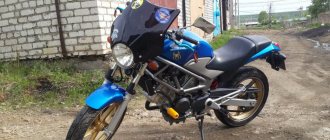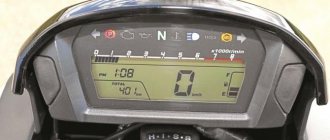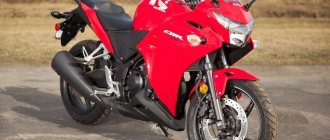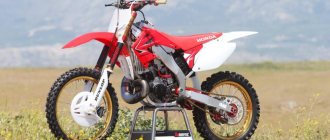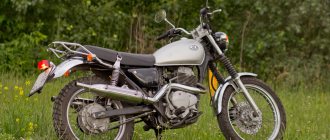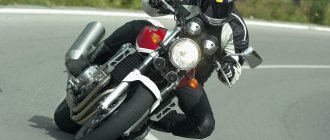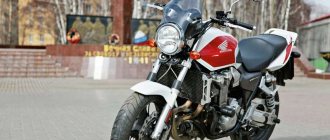Content
- 1 General characteristics
- 2 Manuals (manuals) 2.1 Service manual
- 2.2 Operation manual
- 2.3 Wiring diagram
- 3.1 2002 RR2 3.1.1 NH196
- 3.2.1 NH1B
- 12.1 Original stars
- 16.1 Replacements for the original stator
General characteristics
General characteristics:
- Engine capacity 954 cm3;
- Tank volume 18 liters.;
- Dry weight 168 kg. (170 kg California Type);
- Curb weight 195 kg. (197 kg California Type);
- Dry engine weight 61.2 kg;
- Cylinder compression 12.2 kg/cm2. at 350 rpm;
- Compression ratio 11.5:1;
- Generator power 421 W at 5000 rpm;
- Idle speed: 1200 +-100 rpm.
- Intake valve clearance: 0.16 +- 0.03 mm;
- Exhaust valve clearance: 0.27 +- 0.03 mm;
Honda CBR 954 – a motorcycle that failed
Honda CBR 954 is a Super Sport motorcycle from the famous Japanese manufacturer.
This model did not become something outstanding and is perceived by many solely as an intermediate step from the legendary CBR 900 to modern variations of the CBR 1000. However, it cannot be said that the 954 was an outright failure; one of its undoubted advantages should include real sporty “anger” , previously not so clearly expressed in Honda. But this was not enough to dislodge the main competitor Yamaha YZF-R1, the unsurpassed leader of the early 2000s, from the podium. This is exactly the task that was set when creating the CBR 954, and it is precisely because of its failure that this model is assessed as not the most successful.
Honda CBR 954 is a development of Tadeo Baba and was first introduced in 2002. Based on the name of the model, it is obvious that the engine of the previous 900 series was thoroughly redesigned, adding 54 “cubes”, and also increased the volume of the radiator
ra and injector. In addition, the new product was equipped with a more powerful computer and the structure was strengthened. At the same time, Japanese designers also worked on reducing weight, lightening the motorcycle to 168 kg. As for the dimensions, they are as follows: length 2025 mm, wheelbase 1400 mm, seat height 815 mm, front wheel 120/70-ZR17, rear wheel - 190/50-ZR17.
At the output, the power plant received the following characteristics: 4-cylinder in-line engine with a capacity of 954 cc. cm; 4-stroke; DOHC distribution system; liquid cooling system; 4 valves per cylinder; cylinder diameter 75 with piston stroke 54 mm; compression 11.51. Maximum power was 151 hp. at 11250 rpm, maximum torque - 105 Nm at 9500 rpm.
The redesigned engine, of course, added that notorious “anger”. But due to the significant reduction in weight, it lost strength. Situations often arose when, even with a slight fall on the left side, the CBR 954’s crankcase suffered, even to the point of complete destruction of the left cover. If the fall was strong, then the generator would break down. Lightening the weight also affected the reliability of the timing belt - there was some desiccation of the valves. And this despite the enviable quality of previous Honda engines.
The transmission has been modernized to a lesser extent. The CBR 954 has everything in order: a reliable “native” 6-speed gearbox, drive type - chain.
Alas, the frame and body kit were not without the same shortcomings as those inherent in the engine. Even the traditionally durable plastic cladding cannot save the fragile design of the bracket. And the front spider causes caution - even minor falls lead to its deformation. And, of course, you can’t count on super-accurate riding on a sportbike.
But the suspension with an optimal set of adjustments is pleasing. The front suspension travel is 120, the rear – 135. But it’s not worth it to frankly “kill” it. The bearings of the front wheel and steering column do not last forever. Therefore, it is not recommended to jump too often on the CBR 954, given the hard landings on domestic roads.
The motorcycle is equipped with double disc front brakes and single disc brakes at the rear. The front brake diameter is 330 mm, the rear brake is 220 mm. Reviews about the operation of these mechanisms are most flattering. It is believed that only radial systems perform better, but at the beginning of the 2000s, what the CBR 954 was equipped with was rightly assessed as the optimal solution.
As always, Honda took care of comfort. Driving the CBR 954 is pleasant and comfortable, despite all the “angry” and sporty nature of the model. Even a raised saddle does not cause fatigue. One gets the feeling that the motorcycle can be used for long trips, although the suspension will probably have to be lowered.
And, of course, the Japanese manufacturer has not gone away. The CBR 954 is distinguished by excellent handling and “friendliness” to the motorcyclist. Quite compact, not wide, which is indispensable in traffic jams. The only disappointing thing is that the steering angle is not too large, which makes maneuvering difficult. But the car behaves decently when cornering, and it doesn’t let you down when braking. As for high-speed driving, the CBR 954 is comfortable to travel in the range from 140 to 220 km/h. If desired and possible, you can overcome the barrier of 300 km/h.
Alexey Chernov
Honda (Honda): both a car and a cultivator
ATVs: a fashionable hybrid of a jeep, motorcycle and tractor
Motorcycle helmets: the first line of defense
Kawasaki (Kawasaki): from a bicycle with a motor to exclusive motorcycle equipment
Article tags:
- Honda
- motorcycles
|
|
Manuals
Service manual
Service Manual
) for the Honda CBR954RR motorcycle (2002-2003 onwards) - .
Manual
Owners Manual
) motorcycle Honda CBR954RR (2002-2003 onwards) - .
Wiring diagram
All diagrams are taken from fireblades.org
Electrical diagram of the American and Canadian model Honda CBR954RR 2002-2003.
Electrical diagram of the European model Honda CBR954RR 2002.
Electrical diagram of the European model Honda CBR954RR 2003.
Electrical diagram (model not identified) Honda CBR954RR black and white
Motorcycle Honda CBR 900RR Fireblade (CBR 954RR) 2002 review
Description of the motorcycle Honda CBR 900RR Fireblade (CBR 954RR) 2002 is in the queue for publication of the article. Announcement: Today, for almost every new motorcycle that comes into being, marketers strive to carve out their own niche. This one is a road sport, this one is a recreational enduro. But what class should we include a motorcycle that has a little bit of everything? A good bike should have a reliable engine, comfortable ergonomics and simple controls...
Honda CBR 900RR Fireblade (CBR 954RR) is a motorcycle not sold in Russia, equipped with a very high-power 154 hp engine. Despite the fact that good models of motorcycles have a very respectable price, and the season for their use is relatively short, the motorcycle market is developing rapidly. And if you believe the words of dealers, then some models of recently released motorcycles are selling like hot cakes at the beginning of the season, and the models brought to Russia are clearly not enough to fully satisfy consumer demand.
A motorcycle has long ceased to be an alternative to a car, and the times when this equipment was bought only because there was not enough money for a full-fledged car are forgotten. Nowadays, two-wheelers can be called technological marvels in many cases, and their cost can be compared with that of prestigious cars.
Many people have started buying motorcycles for hobby purposes as riding or even collecting them has become a good pastime for many people. Many motorcycles, for example the Honda CBR 900RR Fireblade (CBR 954RR), the technical characteristics of which allow the model to be called a prestigious brand, are in demand among both beginners and experienced motorcyclists.
Currently, it is impossible to purchase a new Honda CBR 900RR Fireblade (CBR 954RR) motorcycle of the 2002 model year, since their production stopped 14 years ago. At the same time, the Honda CBR 900RR Fireblade (CBR 954RR) has excellent technical characteristics, so many are eager to purchase, if not a new, then at least a used version.
Motorcycles with an engine capacity of 9 54cc / 58.2 cc. in cubic see, appeared as a result of long work of inventors who sought to create a model that was not inferior in characteristics to other versions of the motorcycle. In some cases, these models are not only not inferior, but also ahead of other motorcycles, as they have minimal fuel consumption and other excellent parameters.
Go to the entire range of Honda motorcycles, on this page you can find Honda CBR 900RR Fireblade (CBR 954RR) motorcycles from other years of production and information about them
Front fork
General information:
- The diameter of the fork leg is 43 mm.
; - Honda SS-8 10w
in each feather,
513 cm3.
+-2.5 cm cu. (about one liter of oil is needed to repair the entire fork); - Fork spring length: 255.8 mm
(service limit 250.8 mm).
Original spare parts:
- Set of oil seal, boot for one feather: 51490-MCF-000
- Boot separately: 91256-MCF-003
- Upper fork guide: 51415-MCF-003
- Lower fork guide: 51414-MCF-003
Analogues from All Balls Racing:
- Set of guides and related elements All Balls 38-6088
- Set of boot and seal All Balls 56-133-1
(in the box there are two boots, two seals) - Oil seals only (2 pieces per box) All Balls 55-120
- Anthers only (2 pieces per box) All Balls 57-108-1
Drive chain
Uses 530 chain
with
108 links
.
The manual lists the following models:
- DID 50VA8 C1
- RK GB50HFOZ5
Also suitable:
- DID 530VX
Allowable chain slack is 40-50 mm.
(chain slack by more than 50 mm can damage the pendulum/frame).
The tightening torque of the rear wheel axle nut is 113 Nm
.
When riveting the “pins” of the chain lock, you must comply with the following requirements:
- Pin elevation length: DID
: 1.15 - 1.55 mm;
RK
: 1.2 - 1.4 mm; - Diameter of the riveted part of the “pin”: DID
: 5.50 - 5.80 mm;
RK
: 5.45 - 5.85 mm.
Review of the Honda CBR 900 RR Fireblade motorcycle (CBR900RR, CBR919RR, CBR929RR, CBR954RR)
The engine on the motor is excellent; there have been no malfunctions in 30,000 km. It pulls well, there was enough power reserve. The maximum I could squeeze out of it was 300 km/h, and the navigator showed 275 km/h. They write that you need to use gas on it more carefully, the engine is powerful and it easily gets on the rear wheel up to 3rd speed, well, the fact that the engine is powerful is yes, you need to use gas really carefully, but the fact that it easily gets on the rear wheel up to 3rd speed is nonsense!!! to put it on the rear wheel you need to be able to do it, but just stupidly when you open the gas it accelerates and nothing more! The brakes are not bad either, the bike makes stoppies easily.
With my height of 183 cm, I found it quite comfortable to sit on both fires, except that the 919 clip-ons are a couple of centimeters higher, less sporty and better for long roads. I know that on the 1999 919 the clip-ons are EVEN higher. In terms of ergonomics, the pilot's seat is clearly designed for people of European height. Overall I felt much more comfortable than the 1994 cbr400rr. On the fire, the legs are less bent at the knees, the tank is wider and the steering wheel is closer, it is quite comfortable to hug the tank with your legs when braking. But it’s not very easy to hang from the fire in turns because of the same width of the tank: you’ll have to practice the splits and stretching quite a bit))) But I’m used to it. The moderately long seat allows you to move back efficiently at high speeds and hide behind the fairing. By the way, my 893 had double-bubble glass, thanks to which I could not duck down to 160 km/h easily, and only bend down slightly at 200-220. I usually don’t even drive on highways anymore, I’m more interested in turns...
It doesn't go below 2500. Normal driving starts around 6000... and if you are on the track, then it is better not to lower the tachometer needle below 8000... that's where the engine lives its full life. If in first gear you raise the tachometer needle to 6000 and sharply open the gas, you will feel a high-quality kick in the ass and how the front wheel lifts off the ground... but it only jerks off the gas in first. The clutch lifts up to both 2 and 3, but I’m not a fan of killing the basket and gearbox... To drive around the city, it’s enough to turn the engine in the range of 3000 - 6000. Move around in traffic jams by priming the clutch in second gear, because the first one is too nervous. With such a ride, the consumption of the motorcycle is somewhere around 6.5 - 8 liters per hundred. By the way, the horse digested 92 gasoline perfectly. I tried to pour both 95 and 98, but did not notice a noticeable difference in acceleration or anything else.
The motorcycle is excellent, dynamic, as they say, “user friendly,” that is, to me. Tightly built, fast, excellent brakes, stable on the road. Very compact. You feel quite comfortable in traffic jams, due to the fact that the motorcycle is quite narrow. The only annoying thing is that the steering angle is too small, making it inconvenient to maneuver in traffic jams. In terms of travel speed: I can’t boast of a 300-kilometer threshold, but the speedometer showed 299 km/h several times. There was a GPS nearby, which showed a maximum speed of 282 km/h. It is comfortable to move at speeds from 140 to 220 km/h - this is also the merit of travel glass. It stands perfectly in turns, does not fall inward when braking, and reliably maintains a large angle of inclination without slipping. Be careful on wet roads and in corners - careless operation of the throttle in lower gears threatens to cause the rear wheel to skid, and this is fraught... There were a couple of cases, but everything turned out okay. The instrument panel is quite informative, the tachometer is analog, all other indicators are on the LCD display. I liked the 2 daily odometers. I didn’t like the lack of a fuel level sensor (there is only a light that lights up when there is 3 liters left), the lack of an alarm system.
Stars
Original stars
- Original drive sprocket 16 teeth: 23801-MCJ-750
- Original driven sprocket 42 teeth (in European models): 41201-MEL-D20
- Original driven sprocket 43 teeth (in American and Canadian models): 41201-MCJ-670
Similar to JT Sprockets
- Drive sprocket 16 teeth: JTF 333.16
- Driven sprocket 42 teeth: JTR 1306.42
- Driven sprocket 43 teeth: JTR 1306.43
Analogue ESJOT
- Drive sprocket 16 teeth: ESJOT 50-35023-16
- Driven sprocket 43 teeth: ESJOT 50-35048-43
Drive sprocket bolt tightening torque 54 Nm
.
The tightening torque of the driven star nuts is 64 Nm
.
Brake pads
Original front brake pads (set for one caliper): 06455-MBW-E12
or
06455-MBW-E11
or
06455-MCF-006
or
06455-MCF-016
Original rear brake pads:
43105-MW0-415
or
43105-MW0-405
Front analogs
brake pads:
- Nissin 2P-245
- Brembo 07HO45.XX (where XX is the purpose of the pads RC, SC, SA; more details am-moto.brembo.com)
- Lucas/TRW MCB703
- EBC FA265
- Dunlopad DP 127
- Carbone Lorraine 2711
- SBS 734
- Vesrah VD 166
- Premier P252
- Goodridge GH252
Rear analogues
brake pads:
- Nissin 2P-244
- Brembo 07HO36.XX (where XX is the purpose of the pads SP, 07; more details am-moto.brembo.com)
- EBC FA 174
- Dunlopad DP 121
- Ferodo FD 754
- Carbone Lorraine 2298
- SBS 657
- Vesrah VD-163
- Semc HO 32
- Lucas/TRW MCB 634LF
- Premier P59
- Goodridge G59ST
Tightening torques for calipers and their components required when replacing brake pads:
- Bolts securing the front
calipers to the fork legs - 30 Nm. - Caliper pad guide (both front and rear) - 18 Nm.
- Caliper pad guide plug (present only on the rear caliper) - 2 Nm.
- The front wheel axle is 78 Nm.
- Bolts clamping the front wheel axle - 22 Nm.
- The bolt securing the rear caliper is 22 Nm.
Honda CBR954RR Fireblade
text from Motorreview:
Dmitry Safonov
Honda CBR954RR FireBlade:
2002–2004. $8500–11500
Another attempt to return the highest step of the podium, which by that time was already firmly occupied by the Yamaha YZF-R1. A very serious attempt, but, alas, unsuccessful. In principle, this is the most “evil” Razor of all the 900s. In some ways it was a step forward. But in terms of reliability, alas, it’s a step back.
Engine
The same 900th engine was once again “ploughed”, lightened, dried out, and so on and so forth. In general, all the juice and strength were squeezed out of the design of the “shaggy” year. The result was immediate. The engine has become angrier, but, alas, “cardboardier.” Even small falls on the left side lead to complete destruction of the left crankcase cover. In more serious falls, the generator is destroyed, and often even rips out the crankcase bosses under the cover bolts. Measures to lighten the timing parts have led to a decrease in its reliability - there are known cases of valve desiccation. Interestingly, the engine continued to work! In general, the reliability of the engine has greatly decreased, especially in comparison with the legendary indestructibility of the previous ones.
Transmission
Everything is still the same – Honda! And no amount of engine boost could “kill” the reliable gearbox.
Frame and body kit
The front spider is rather weak - it suffers greatly even with small falls. And in general, the entire design of the bracket is too flimsy. However, the plastic facings are still durable and resistant to falls.
Pendants
Wonderful pendants with a full range of adjustments. It is not recommended to get carried away with driving “in the candle”, which entails hard landings - the bearings of the steering column and front wheel will not withstand such abuse for a long time.
Brakes
Brakes of a modern sportbike. The only thing better is the radial systems, which have become a hit in the last two years.
Comfort
Even in creating extreme sports bikes, Honda remained true to itself. Despite all the sportiness of the landing, the raised “fifth point”, it is still comfortable on it. In principle, if you loosen the suspension, then you can swing it at long range. It’s just that the rhythm of the movement will be different: an angry smoke break – a smoke break – a smoke break, and not a grab-rest.
Modifications
This is the last motorcycle in the evolution of the series with a first generation engine.
The next one was a full-fledged “liter”, dividing all fans of the model into two camps - disappointed and enthusiastic. We thank Alexey “Samodelkin” for his advice in preparing the material. parameters
Engine: 954 cm3, 4-stroke, 4-cylinder, in-line, DOHC, 16 valves, liquid cooling Maximum power: 151 hp
at 11250 rpm Maximum torque: 105 Nm at 9500 rpm Length: 2025 mm Wheelbase: 1400 mm Dry weight: 168 kg Front tire: 120/70–17 Rear tire: 190/50–17 Technical data: 954 cc , liquid cooled, 4 - cylinders, 4-stroke, Bore x stroke (mm) 75 mm x 54 mm, Valves 4 valves/cylinder, Power 152 hp (113.3 kW) @ 11250 rpm, Torque 105 Nm (77.4 ft. lbs) @ 9500 rpm, Gearbox 6 speed Final drive Chain, Front tire 120/70-17, Rear tire 190/50-17, Front brakes dual 330 mm discs with 4-piston calipers, Rear brakes single 220 mm disc with 1-piston calipers , Wheelbase 1400 mm , Fuel capacity 18 l , Dry weight 168 kg
